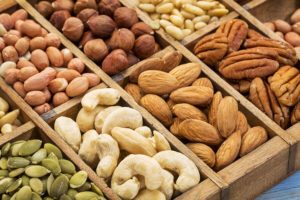 Experts have been talking about the obesity problem in the United States for years. Despite the focus placed on weight loss, researchers say that many people are still eating too many “bad” carbs. In fact, a recent study showed that many Americans are still getting 42 percent of their calories from low quality carbohydrates. Unfortunately, the study also showed that few people have increased their intake of good carbs. Though you may understand that some carbs are healthier than others, it’s hard to reduce the “bad” carbs in your older family member’s diet if you don’t know which carbs are good and which ones are bad.
Experts have been talking about the obesity problem in the United States for years. Despite the focus placed on weight loss, researchers say that many people are still eating too many “bad” carbs. In fact, a recent study showed that many Americans are still getting 42 percent of their calories from low quality carbohydrates. Unfortunately, the study also showed that few people have increased their intake of good carbs. Though you may understand that some carbs are healthier than others, it’s hard to reduce the “bad” carbs in your older family member’s diet if you don’t know which carbs are good and which ones are bad.
What Is the Difference Between “Bad” Carbs and “Good” Carbs?
There are two basic kinds of carbohydrates: simple carbohydrates and complex carbohydrates. Simple carbs are the ones that have natural sugars in them. They are easy for the body to digest and offer fast energy. Some sources of simple carbs are fruits, dairy products, and some vegetables. Simple carbs are also found in processed foods, including soda, pastries, and white sugar. Complex carbs contain a lot of fiber and starch. They take the body longer to digest. Some sources of complex carbs are whole grains, beans, and legumes.
Many of the foods that are considered bad carbs are simple carbohydrates. They don’t have as much nutritional value. Typically, they are processed foods, like boxed mixes and baked goods. While many bad carbs are simple carbs, not all simple carbs are bad. For example, some fruits contain simple carbs, but they are still considered good carbs because they provide vitamins and minerals.
What Are Some Carbs Seniors Should Eat?
A healthy diet does not cut all carbohydrates. Carbohydrates are necessary for energy and many sources of carbs contain nutrients that are essential to good health. Some good carbs that older adults should eat regularly are:
Vegetables: Eating a wide variety of vegetables in different colors ensures the senior gets all the nutrients they need.
Whole Grains: Read the ingredient list on packaging to determine if the product contains whole grains. A whole grain should be included as one of the first few ingredients. Some examples are brown rice, quinoa, oats, and barley.
Nuts and Seeds: Nuts, like almonds and walnuts, make an excellent snack that is also rich in protein. Seeds can be added to salads, soups, and in baked goods.
Whole Fruits: Keep whole fruits, like apples and bananas, washed and ready to eat for an easy to grab snack.
Beans and Legumes: Beans and legumes are another good source of protein and are also filling.
Tubers: Potatoes and sweet potatoes are examples of tubers.
Senior care providers can prepare meals for your older family member that include plenty of good carbohydrates and only the occasional bad carb as a treat. A senior care provider can assist with meal planning, taking into account any special dietary needs. Senior care providers can also take the older adult grocery shopping and help to put the groceries away.
Sources: https://www.webmd.com/diet/news/20190924/americans-are-still-eating-too-many-bad-carbs#1
https://www.healthline.com/nutrition/good-carbs-bad-carbs
https://www.verywellfit.com/good-and-bad-carbohydrates-3121405
